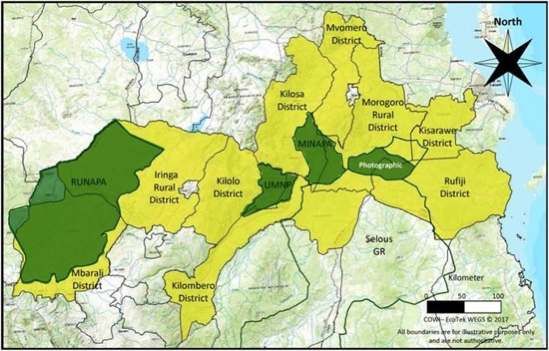Thrive with ecotourism – The case of the REGROW project in Tanzania

Summary
The Resilient Natural Resource Management for Tourism and Growth (REGROW) project, funded by the World Bank, has the combined objective of improving the management of natural protected areas and their ecosystems in the southern highlands of Tanzania and creating livelihood opportunities that enable economic development and growth for the targeted communities.
The effects of climate change are being felt in the south of the United Republic of Tanzania, with the highlands particularly affected. Rising temperatures and rainfall are increasingly unpredictable, and there have been changes in rainfall patterns, leading to severe droughts. The combination of these effects greatly affects ecosystems and the ecosystem services on which the livelihoods of the region’s people depend.
Tanzania’s tourism is predominantly wildlife-based, but the decline in species has reduced the attractiveness of the sector. Moreover, the limited infrastructure of the “Southern Circuit”, such as airstrips, visitor services, and logistical facilities, is another obstacle to attracting tourists. The REGROW project aims to strengthen the management of protected areas and foster livelihood diversification through community-based approaches that enhance and expand local opportunities. It will support the development of local tourism programs by improving tourism infrastructures such as roads and transport services that ameliorate access to natural parks. In addition, community-based tourism will be encouraged for involving the population to participate in tourism activities. Economic opportunities such as those offered by this project can improve their livelihoods and reduce their vulnerability to the effects of climate change, in turn reducing pressure on natural resources, which benefits both the flora and fauna of these ecosystems.
The project was designed for the Southern Circuit, which includes the national parks of Katavi, Kitulo, Mahale, Udzungwa, Mikumi, and the Ruaha Mountains, all of which have different tourist attractions.
Overview
- Location:
- Implementation sites:
- Single country
- Multiple locations
- Mountain region:
- Katavi, Kitulo, Mahale, Udzungwa Mountains, Mikumi and Ruaha
- Province:
- Southern Circuit
- Solution scale:
- Ecosystem type(s):
- Solution type(s):
- Climate impact(s) addressed:
- Impact time-scales:
- Co-benefits:
- Implementation timeline:
- 2017 - 2023
Solution details
Main beneficiaries & outcomes
The project directly benefits some 20,000 households living near the priority protected areas, who, as well as tour operators and related businesses, will experience increased economic gains from higher tourism. Another 20,000 farmers located in the Great Ruaha River sub-basin are being supported with more efficient irrigation and production methods. In the case of government agencies and officials, those working in the water, agriculture, land management, wildlife, tourism, and protected area management sectors in southern Tanzania, will benefit from capacity-building activities.
The project helps promote landscape and biodiversity conservation and enhances the livelihoods of communities, which in turn reduces unsustainable activities in protected areas. A gender-based approach is employed with the objective of providing opportunities for disadvantaged groups, including women and youth.
Planning and implementation
With support from the World Bank, the Government of Tanzania is implementing the project through existing government structures within ministries, agencies, regional secretariats, local government authorities, and community institutions, led by the Tanzania National Parks Authority (TANAPA) and the Ministry of Natural Resources and Tourism (MNRT). To facilitate the coordination of activities, both a Project Steering Committee (PSC) and a Project Coordination Unit (PCU) have been created including representatives from all involved institutions.
In the case of beneficiaries, they will participate in participatory monitoring activities, providing feedback on the quality of services. They include participants from the private sector, development partners, civil society, and others.
Finance
The project is being financed with a US$150 million loan from the International Development Association (IDA), a member of the World Bank group.
| Project Components | Cost (USD Millions) |
| 1. Strengthen management and improve infrastructure in priority Protected Areas. | 97.00 |
| 2. Strengthen alternative livelihoods for targeted communities in proximity to the priority Protected Areas. | 17.00 |
| 3. Strengthen landscape management and infrastructure investments in and upstream of the Ruaha National Park. | 27.00 |
| 4. Project management, institutional strengthening, quality assurance and control, and monitoring and evaluation. | 9.00 |
| Total | 150.00 |
Source: The World Bank, 2017.
Innovation
The project supports tourism and provides economic opportunities to the local communities to enhance their livelihoods and reduce their vulnerability to the effects of climate change, in turn reducing the pressure they have exerted on the natural resources, which benefits both flora and fauna in these ecosystems. Among many of its activities, it will develop an innovative model of water resource management, through increased efficiency gains and with the potential to be replicated in other key national watersheds.
Performance evaluation
The project’s performance is being monitored and evaluated as part of its Component 4 (project management, institutional strengthening, quality assurance and control, and monitoring and evaluation), which finances activities such as the collection of data on the physical and financial progress of the solutions, the performance of implementing agencies and service providers, and the results achieved in terms of outputs and outcomes. To support this objective, a baseline study, perception surveys, knowledge generation and sharing, annual networking among key project stakeholders, and an impact evaluation will be conducted.
Long term project sustainability and maintenance
The long-term sustainability of the project is sought through the strengthening of environmental, social, and financial aspects as its three main pillars, which are being addressed by its first three components. At the same time, the success of the project’s results in terms of tourism is being pursued by the integration of communities surrounding the protected areas in the targeted locations.
Capacities for design and implementation
Knowledge
The project design benefited greatly from several technical studies financed during the project preparation phase, rich peer-reviewed reports, and in-depth studies related to natural resource management, tourism, and poverty in the country. For instance, component 2 was included in the project as a result of several studies that revealed that, in the north of the country, some of the poorest communities are located around protected areas and that, in the south, those communities do not benefit from tourism products, for various reasons, such as lack of skills and capacities, and limited mechanisms that promote interaction between communities and tourism stakeholders. In this case, the inclusion of this component seeks to avoid repeating the same mistakes and help address poverty by increasing natural resources conservation and fostering tourism activities.
Technology
Advanced technologies, together with knowledge, served for the designing of some component 3 activities where satellite images previously prepared by the European Space Agency were employed to illustrate land cover evolution in the past decades.
Political / Legal
The government’s motivation to foster economic growth in the southern regions of the country is a strong driver for this project, making the use of existing government structures and the alignment of activities with national policies and programs crucial to its success. The project measures are fully aligned with Tanzania’s vision of scaling tourism as an engine of development in the Southern Circuit and have been designed in close consultations with the Ministry of Natural Resources and Tourism (MNRT) teams preparing a new National Tourism Policy and a National Tourism Strategy.
Institutional
In addition to government institutions, the project also works in coordination with private sector representatives and community groups down to the village level, for which the project steering committee and the technical monitoring and evaluation group are instrumental in maintaining cooperation and coordination.
Socio-cultural
Communities in the targeted areas have been involved in different activities useful to the project, such as satisfaction surveys with the intention of drawing lessons and making adjustments to measures if appropriate. Through its different components, the solution aims to facilitate and support cross-sectoral and cross-level stakeholder interactions, therefore a national stakeholder committee has been integrated into the project’s institutional arrangements to ensure the full commitment and participation of the Southern Circuit’s stakeholders, including the private sector and civil society. Awareness raising and promotion of conservation activities are carried out at the community level.
Outlook & Scalability
Barriers and adverse effects
Some of the barriers initially identified by the project executing institutions include (but not limited to):
- Probabilities of corruption and fraud at the political and government level, as well as conflicting interests.
- The government’s intentions to turn Tanzania into an industrialized country could put additional pressure on resources.
- Lack of experience of institutions in implementing large projects.
- Possibility of unintended and/or temporary negative impacts from activities such as the development of infrastructure within priority protected areas or irrigation schemes.
Although no information is yet available as to whether these obstacles/risks have been overcome, the fact that they were initially identified enabled the design of appropriate strategies to prevent them from affecting the success of the project.
Transformation and future outlook
The ambition driving the design and investment of the REGROW project is to create a viable platform for growth that can better utilize the region’s natural endowments to transform southern Tanzania in terms of economy and sustainable tourism. It aims to halt the degradation of the region’s ecosystems in the future and raise awareness of their importance to the surrounding communities.
Potential for upscaling and replication
Lessons and analytical results from the project are to be extended to the protected area management and water resource management sectors and could be replicated in areas with similar conditions in the country. At this time, there is still no information about a possible replication or extension of the project.





(0) Comments
There is no content